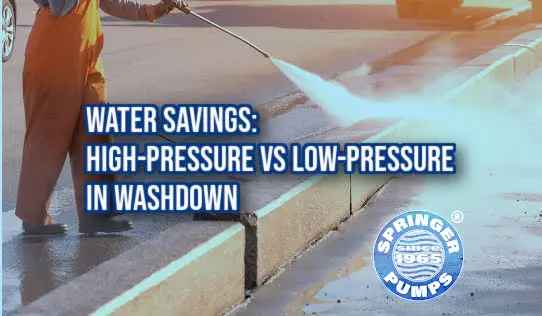High-Pressure to Low-Pressure Washdown Cleaning System Comparison
(900-1100 psi vs. low pressure 250 psi)

The basic reason for using a high-pressure cleaning system is to create an effective impact while minimizing water usage. Rather than a low-pressure high volume system that requires twice the water to generate an effective impact.
Pressure is only one of three variables that you can manipulate to vary impact.
Impact is a relationship of three factors:
- Volume
- Spray angle
- Pressure
This is a very critical point to remember because of the widespread misconception that high pressure will hurt people or damage equipment. If you doubt this try the following, place a plastic tub or trash can, with three gallons of water in it, on the floor and spray it with one of the drops (250 psi) in your plant with no nozzle on the hose and observe what happens. Now take the hose, put a small nozzle on it and repeat this experiment. You will notice that the hose with no nozzle hits much harder. What happened is you varied the volume factor of the equation and thus dramatically increased the impact with no change in pressure.
High PRESSURE WILL ALLOW YOU TO DO IS SAVE WATER BY MAINTAINING AN EFFECTIVE IMPACT AT MINIMUM WATER CONSUMPTION. HIGH PRESSURE WILL NOT DAMAGE ANYTHING IF YOU USE THE CORRECT NOZZLES. The formula for impact (lbs) is: Impact Factor * .0526 * GPM @ spraying pressure * the square root of the spraying pressure in PSI The impact factor is a function of spray angle - see the following chart (measured at 12 inches from nozzle tip):

Spray Pattern
|
Angle (degrees)
|
Impact Factor
|
| FLAT FAN |
5 |
.50 |
| FLAT FAN |
15 |
.30 |
| FLAT FAN |
25 |
.18 |
| FLAT FAN |
35 |
.13 |
| FLAT FAN |
40 |
.12 |
Example 1 - A typical 250 psi system
250 psi, 15 GPM, 5-degree nozzles
impact = 6.30 lbs
Example 2 - Thomas Pump high-pressure system
900 psi, 8 GPM, 5-degree nozzles
impact = 6.31 lbs
While the mathematical justification is interesting for the purpose of this discussion we will state the following as fact.
- If the nozzle size (flow rate) is increased impact will rise.
- If the nozzle spray angle is narrowed the impact will rise.
- If the nozzle Pressure is increased the impact will rise.
If you do the opposite impact will fall. The key is to manipulate these three variables in order to get enough impact to effectively clean a food processing plant while minimizing water consumption. The above two examples are a comparison between a low-pressure system and a Thomas Pump high-pressure system. The volumes of the nozzles are based on our experience of what works well at these pressures. If your plant is using nozzles with wider spray angles, even more, water per nozzle is needed to get effective cleanup. Because we don't have exact numbers for your plant we are going to make the following assumptions. (1) Water cost estimates are as follows:

$1.29/1000 gal. to purchase
$1.55/1000 gal. to treat
$1.16/1000 gal. to heat
$4.00/1000 gal total water costs
We will also assume:
(2) 10 people using hoses.
(3) The current system pressure is 250 psi.
(4) Current nozzles are 5-degree fan spray angle.
Now using examples 1 & 2 above, your 250PSI system uses 11,700,000 gallons per year (10 men * 15 gpm * 60 min/hr * 5 hours/day * 5 days/week *52 weeks/year) at an annual cost of
$46,800.00. The Thomas Pump system will use only 8 GPM per person or 6,240,000 gallons/year at an annual cost of
$24,960.00.
This represents a savings of $21,840.00 per year for every 10 men on your crew. NOTE: We use 10 people on the crew so that we can easily create a chart that illustrates the savings available for a range of crew sizes. Please match your actual crew size to the chart below to arrive at the actual savings available to your plant.
A
|
B
|
C
|
Crew Size
|
Annual $ Savings
|
$4.00/1000 gals
|
| 25 men |
$54,600 |
13,650,000 |
| 30 men |
$65,520 |
16,380,000 |
| 35 men |
$76,440 |
19,110,000 |
| 40 men |
$87,360 |
21,840,000 |
| 45 men |
$98,280 |
24,570,000 |
| 50 men |
$109,000 |
27,300,000 |
| 55 men |
$120,120 |
30,030,000 |
| 60 men |
$131,040 |
32,760,000 |
Please note the following points; (1) If you look at column C above you will notice that your plant sewage system will have a lot less load on it. This will save maintenance costs, chemical costs, etc. We can’t put a number to this but the savings are real. (2) Normally downsizing of the sanitation crew is possible because impact flexibility allows each man to clean a larger area at the same time. Each man taken off the crew represents a large saving in clean up costs. This downsizing can easily be accomplished through normal attrition because of the turnover rate is usually high. (3) Minor additional savings are available in chemical costs because grime is knocked off instead of dissolved off. (4) As environmental restrictions increase, water costs will continue to rise.
(5) If you have sixty people on your cleaning crew the savings our system provides will pay for the equipment cost in less than 5 months. (6) On new plant construction projects, if the cleaning system volume can be reduced your water heater and your water treatment facilities can be downsized providing substantial initial cost savings. If you can give us your exact numbers regarding water costs and crew size I can supply an accurate ROI. The actual ROI will depend on what size system you need.

 The basic reason for using a high-pressure cleaning system is to create an effective impact while minimizing water usage. Rather than a low-pressure high volume system that requires twice the water to generate an effective impact.
The basic reason for using a high-pressure cleaning system is to create an effective impact while minimizing water usage. Rather than a low-pressure high volume system that requires twice the water to generate an effective impact.




